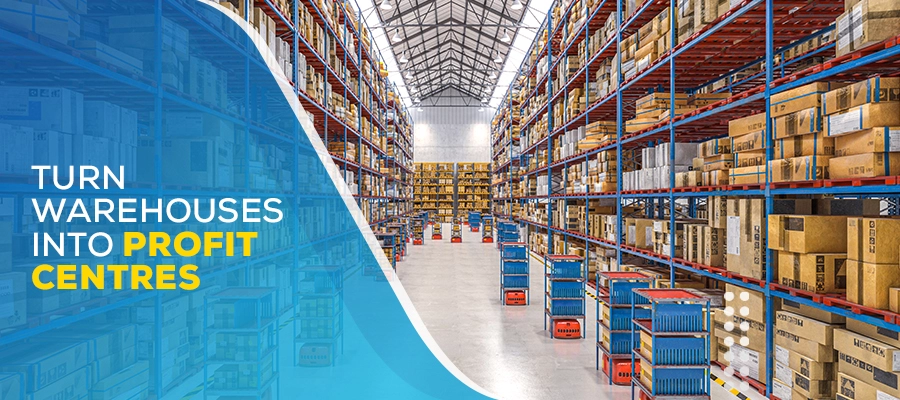Harnessing Efficiency: Warehouse Automation in the Solar Energy Revolution
In today's rapidly advancing world, the solar energy sector stands at the forefront of sustainable innovation.
Read More
Every warehouse requires an abundant investment in space and enormous consumption of resources like manpower, electricity, storage systems, lifting, and material handling equipment. These costs are more significant than the operating cost because, most industries don’t have a regulated methodology to assess this, hence opt for an outsourced 3rd party logistics service to handle their warehouse operations efficiently. But what if results prove that the warehouse turns out to be a profit center rather than a cost center, addressing the ways to integrate the operations can make this possible. Let us see how
The few factors where the percentage of costs is predominant for warehouse operations are:
Inventory management
Material handling time and equipment
Put away and retrieval
Sort and assess

Inventory Management
Managing the inventory plays a major role in streamlining the warehouse operations, this involves maintaining the data of the products stored in the warehouse-like their name, ID, location, quantity, date of shipments, transit details, shelf life, etc. A properly maintained inventory complements the ease of access to all the other 3 factors by
Allocating empty locations to the incoming shipments after material entry
Identification of the picking items
Auto-update of the available stocks
Generate reports for easy evaluation
Maintaining a foolproof database
Manage the continuous replenishment of stocks and their life cycle
All our automated systems like the Pallet AS/RS, Shuttle AS/RS, VStore, Crato – Bin shuttle, Mobile Pallet Racking, and Mini Load AS/RS come with the complement of in-house developed Warehouse Management Software (WMS). Upon using its full capabilities, it enables a warehouse to function independently and as a special addition it can also be integrated with ERP software, and data handling can be done through scanners and AI implemented technologies.
By the incorporation of such an Inventory management method for a warehouse, all of its operational costs are cut down significantly and improves the utilization of resources.
Put Away and Retrieval
Warehouses are typically very large in the area so material retrieval and put away consumes more time. In addition to this, when the height of the building is also utilized it needs to be oriented properly with easy and well-defined visual identification to enable the operators to access the materials quickly. So, we design storage solutions like Selective Pallet Racking, Shelving, drive-in racks, VStore, and AS/RS before its construction to align its orientation along with the docks/staging area so that put away and retrieval operations take place easily at all locations with the shortest available path to travel.
Order Picking
Order picking is crucial because the exact order should be delivered accurately at the right time, right quantity, right quality, right place, and the right person. If order picking errors are in place the handling cost per SKU is doubled. To avoid this, storage systems are designed to complement the material flow with different types of order picking techniques.
An automated vertical storage system like the VStore is well suited for piecewise picking, batch picking, zone picking, and cluster picking. And an AS/RS can be designed to offer the desired type of picking based on the user’s operation whilst maintaining FIFO or LIFO and cutting down movement costs. Static Storage solutions also offer wave picking, piece picking, zone picking, and batch picking which is manually monitored and adds more costs to ensure continuous material movement.
Material Handling
The dilemma of whether to go for an automated storage system with a high initial investment over a costly material handling equipment and static storage system can narrow down to arrive at a conclusion based on the following aspects
| SNo | Dedicated MHE | AS/RS |
| 1 | Requires skilled labour | Anyone can operate |
| 2 | Requires certification and extensive training | Easy to train and adapt |
| 3 | Highly expensive maintenance | Cheaper periodic maintenance |
| 4 | Involves the risk of disasters | Trouble-free operation |
| 5 | The possibility to become a bottleneck | Designed to avoid any bottleneck operations |
| 6 | System height is limited to MHE | Not limited by height |
In addition to this throughput, the number of pallets handled per hour, error identification, ease of use and many more factors bring down the cost of operation significantly in the long run. For a low throughput warehouse with a lower storage need, static solutions tend to be the best option in the long run.
Sort and Access
Sorting mostly takes place during the inbound of the materials and outbound of the materials, if we can manage this flow ideally from the start then costs are well maintained till the end. Sorting the materials helps to maintain a bird’s eye view over all the above-mentioned processes and makes the verification of the stocks and operations in a warehouse much easier, providing more time to dispense on the core activities. A few types of sorting systems are cross belt sorting, line sorter, shoe sorter, etc. On a completely automated line errors is almost nil whereas on a manual line is more of a time-consuming activity and comparatively, probabilities for errors are high.
Hence laying the fundamentals right and strong turns out to be a profit generation activity in the long run for warehouses enabling easy identification, order processing, tracking, and assessment of the stocks with no absolute errors. For a warehouse to be a profit center all these factors are to be considered from planning the building to the storage of goods till the last-mile delivery of the supply chain.